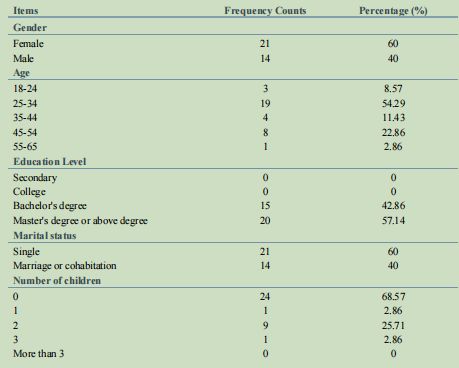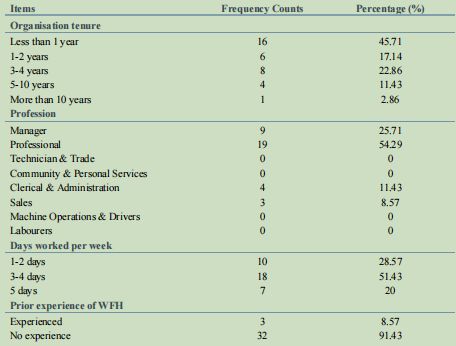Employee Experience Survey: Working From Home Assessment
- Country :
Australia
1. Introduction
Globally, working from home (WFH) has grown in popularity as a result of the COVID-19 pandemic. But these new working arrangements may negatively affect the productivity of employees. A survey was designed to collect workers' experiences to determine how this new configuration might affect their performance. Therefore, a comprehensive strategy for this type of work will be developed based on the results.
The results of preliminary research will help determine the direction of the survey based on common experiences with WFH. Furthermore, there is evidence that a low percentage of WFH employees are satisfied according to several studies. According to the Martec Group 2020 study, only 32% of respondents were satisfied with their WFH configuration [1]. In addition, 50% of respondents felt dissatisfied with their current WFH arrangements, according to the Institute for Employment Studies [2]. In light of this, it is essential to understand why WFH employees had a low employment experience, which in turn affected their performance, and to discover how WFH can be designed to improve that experience.
In order to accomplish this purpose, a quantitative method questionnaire is employed in order to establish the validity of key components and gather insights from those who have experienced the WFH.
2. Literature review
3. Methodology
3.1 Sample and Procedure
The data collection was conducted via an online survey between 14th and 02nd April 2022. The questionnaire was divided into two sections: Part A measured social-demographic characteristics and Part B measured the key components: (1) home-workspace suitability, (2) work-family conflict, (3) job autonomy, (4) workload of WFH, (5) social interaction and organisational support, and (6) supervisor's leadership). Furthermore, the duration of the survey was less than 7 minutes.
The sample was drawn from two sources. One involved postgraduate students and the other consisted of a professional network in Australia. The students were contacted and informed about the survey's purpose by e-mail. In addition, professional network contacts were made via LinkedIn.
To improve the survey's accuracy, the following question was added: (1) Does your enterprise currently or historically practice working from home? Respondents whose companies had not implemented WFH were excluded. If the respondent meets the qualifications, they were able to begin filling out the questionnaire and were assured that their responses were anonymous. Furthermore, the respondents were informed that in case of encounter distress while taking part on the survey they could visit RUOK AU to receive help. Lastly, the survey was tested for comprehension to ensure that the wording and measurement was adequate.
In total, 100 questionaries were sent, and 42 questionaries were returned; of these, 35 valid responses were included in the data analysis. Of those samples, 60% were females, and more than 50% were aged between 25 and 34 years and held a Masters degree or higher.
Table1. The descriptive statistics of respondents characteristics.


3.2 Measurement
For the purpose of facilitating reliability and validity, each question was a closed-ended type and it was graded on a five-point Likert scale (1 indicating strongly disagree, 5 indicating strongly agree).
WFH's experience was measured through measurement of six components representing employee overall job experience.
4. Analysis
4.1 Home-workspace suitability
In the survey, home-workspace suitability was measured with five items including the following:
I have a suitable workspace at home, I am not easily distracted while WFH, I get disrupted by noise while WFH, I have good conditions to WFH, I have satisfactory access to essential/professional IT Tools from home.
- Overall, respondents rated they have a suitable home-workspace, with 80.86% responding
Strongly Agree and Somewhat agree I have a suitable workspace at home, and by I have good conditions to WFH (80%).
- Respondents than have kids tend to rate Somewhat disagree (60%) and Somewhat agree (20%) to I have a suitable workspace at home. Followed by Somewhat disagree I have good conditions to WFH (75%) and Somewhat agree (15%).
- Furthermore, respondents rated that they dont get easily distracted or get disrupted while WFM, with 57% and 60% respectively. Finally, respondents have access to IT tools with 86% responding Strongly agree or Somewhat agree.
4.2 Work-family conflict
In the survey work-family conflict was measured using five items: I can balance work and personal life, I work from home with other members of the household, My family members support me while WFH, I can easily shut down work mode when the day is over, I can successfully separate work from my personal life.
- Over 70% of respondents rated they receive support by family member as Somewhat agree or Strongly agree.
- Respondents valued I can separate work from my personal life with 69% responding Somewhat agree or Strongly agree, followed by I can balance work and personal life (65%).
- Respondents rated I can easily shut down work mode, with 54%. While 45% responding Strongly disagree or Somewhat disagree.
- Finally, 46% of respondents work from home with other members of the household.
4.3 Job autonomy
For measured job autonomy the following questions were formulated: I am allowed to choose the procedures to utilise about my job, I am able to schedule my work according to my needs, I can change my job objectives as necessary, I am able to decide what work I should perform, I am able to work independently.
- Almost 90% of respondents were Somewhat agree or Strongly agree with the statement I am able to work independently.
- When asked of their autonomy of schedule their job according to their needs, 60% of respondents said they were Somewhat agree or Strongly agree.
- Furthermore, when asked if they were allowed to choose the procedures about their job, 55% of respondents were either Somewhat agree or Strongly agree.
- While less than 35% of respondents can decide what work they should perform and be able to change their job objectives as necessary.
4.4 Workload of WFH
In the survey, five sample items were measured: My work can be completed without the need for overtime, I am able to stick to my work schedule, My online meetings last for a reasonable amount of time, I receive all the information I need to complete my work on time, I have the possibility to focus more on my tasks instead of online meetings.
- The majority of respondents (79%) Somewhat agree or Strongly agree with their possibility to focus more on tasks instead of online meetings, followed by their ability to stick to their work schedule (74%) and have all the information they need to complete their work on time (74%).
- The majority (63%) of respondents Somewhat agree or Strongly agree with the statement Online meetings last for reasonable amount of time, followed by My work can be completed without the need to overtime (62%).
4.5 Social Interaction and organizational support
Sample items included the following: When I faced difficulties, my teammates helped me identify the cause and suggest possible solutions, When I struggled, my teammates comforted and encouraged me, I feel comfortable sharing personal matters with my teammates, I have good communication with my teammates during WFH, I maintain social contact with my teammates outside of work.
- Almost 90% of all respondents have supported of teammates while they faced difficulties.
- Eighty-two (82%) of respondents rated Somewhat agree or Strongly agree about having good communication with teammates while working from home.
- Around 64% of respondents were somewhat agree or strongly agree with the statement When I struggled, teammates comforted and encouraged me, followed by I feel comfortable sharing personal matters with my teammates (49%).
- In contrast, a small proportion of respondents (33%) somewhat agree or strongly agree that maintain social contact with their teammates outside of work.
4.6 Supervisors leadership
Sample items included the following: My manager explains clearly what is expected of me while WFH, My manager has a leadership style that promotes the team spirit, My manager takes into consideration my actual workload so I can perform well at work, My manager supports my professional and personal development, My manager gives me regular feedback on how I am doing on WFH.
- Over 78% of respondents rated that manager supports professional and personal development as somewhat agree or strongly agree, followed by My manager explains clearly what is expected while working from home (67%) and My manager gives me regular feedback (67%).
- Sixty-four (64%) of respondents were somewhat agree or strongly agree with their manager considering their actual workload so they can have a good perform. Finally, over half (53%) of respondents said they somewhat agree or strongly agree with their manager have a leadership that promotes the team spirit.
Are you struggling to keep up with the demands of your academic journey? Don't worry, we've got your back! Exam Question Bank is your trusted partner in achieving academic excellence for all kind of technical and non-technical subjects.
Our comprehensive range of academic services is designed to cater to students at every level. Whether you're a high school student, a college undergraduate, or pursuing advanced studies, we have the expertise and resources to support you.
To connect with expert and ask your query click here Exam Question Bank

